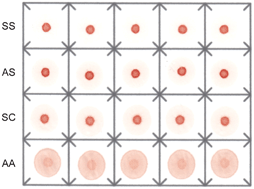Researchers at York University in Toronto have developed an integrated microfluidic device to facilitate analysis of modified protein structures after biochemical reactions.
The platform guides a protein right through from a controlled reaction, functional labeling, and fragmentation zones to a coupled mass spectrometer for determination of the protein’s secondary structure. Using this device, the group conducts the first dynamic structural analysis of the β-lactamase enzyme TEM-1 to identify key regions of the enzyme that affect catalytic activity. TEM-1 is the enzyme that provides bacterial resistance to β-lactam antibiotics.
Protein binding events crucial to protein function can change protein shape directly at the binding site or through another site (an allosteric mechanism). One example of allostery is when the binding of oxygen to one heme site in hemoglobin increases oxygen affinity at other heme sites due to structural changes. For hemoglobin, functional labeling during binding events and mass spectrometry (MS) protein structure analysis was used to find the 3 sets of residues responsible for the allosteric mechanism at each heme site.1 The integrated microfluidic platform described here by Derek J. Wilson’s group enables similar experiments with faster sample transfer to electrospray ionization for MS analysis.
 This integrated microfluidic platform first incubates the protein of interest with a reactant for a controlled time. Then, the amide protons of the backbone are functionally labeled with deuterium and the labeled protein is digested in a pepsin-functionalized region. Finally, the fragments are ionized and transferred into a time-of-flight mass spectrometer (Q-TOF MS). Labeled peptides are quickly delivered to the spectrometer resulting in high retention of the proton label.
This integrated microfluidic platform first incubates the protein of interest with a reactant for a controlled time. Then, the amide protons of the backbone are functionally labeled with deuterium and the labeled protein is digested in a pepsin-functionalized region. Finally, the fragments are ionized and transferred into a time-of-flight mass spectrometer (Q-TOF MS). Labeled peptides are quickly delivered to the spectrometer resulting in high retention of the proton label.
Evaluating TEM-1 after incubation with its inhibitor clavulanate, Wilson’s group notes that regions of the protein which undergo slow changes in deuterium uptake correspond to allosteric transitions and occur on the protein periphery. Rapid changes occur to reposition specific residues, “loosening” some structures and “locking up” others near the active site.
These measurements are the first to analyze TEM-1 inhibition dynamics and demonstrate the great utility of this microfluidic platform to facilitate exploration of allosteric mechanisms and other dynamic structural changes affecting protein function.
1. I. A. Kaltashov and S. J. Eyles, in Mass Spectrometry on the Frontiers of Molecular Biophysics and Structural Biology: Perspectives and Challenges, Wiley Online Library, 2012, pp.186-208.
An electrospray MS-coupled microfluidic device for sub-second hydrogen/deuterium exchange pulse-labelling reveals allosteric effects in enzyme inhibition
Tamanna Rob, Preet Kamal Gill, Dasantila Golemi-Kotra, and Derek J. Wilson
DOI: 10.1039/C3LC00007A
Sasha is a PhD student at Stanford University working with Professor Beth Pruitt’s Microsystems Lab. Her research interests focus on designing microscale devices for studying cell mechanobiology and the biophysical underpinnings of cell-cell and cell-substrate interactions.






















